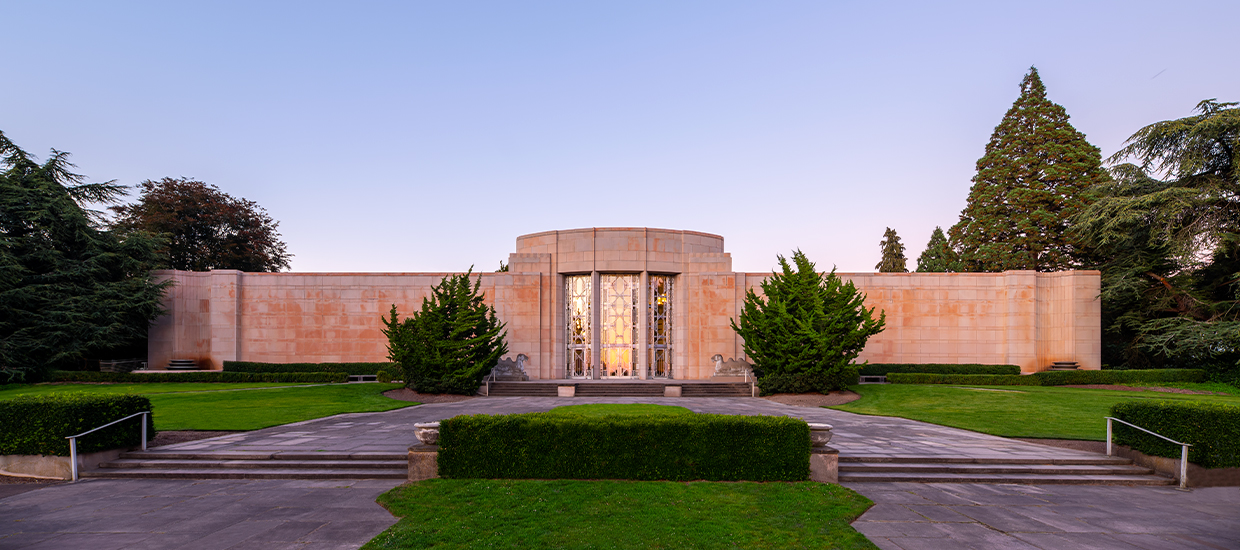A slew of sleek landmarks have been recently reimagined, restored, and reopened
Travel experts predict that the post-pandemic era will be a time of exuberance and decadence—the Roaring 2020s, if you will. Fittingly, there may be no better time to immerse yourself in the sleek, geometric architecture of the original Roaring ’20s, as a slew of Art Deco landmarks have been recently reimagined, restored, and reopened. Miami Beach may remain the preeminent Deco destination, but this global guide shows just how far the 20th century’s most stylish art and design movement spread—and how much it resonates to this day.
Unexpected Art Deco Pilgrimages
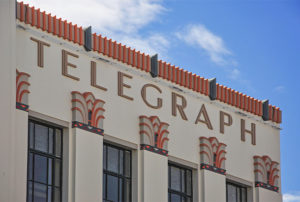
Napier, New Zealand
After a 7.8-magnitude earthquake flattened this North Island seaport in 1931, the town sprang into action, erecting 111 new buildings—many of them designed by Frank Lloyd Wright devotee J.A. Louis Hay—in the next two years. The resulting cityscape is so architecturally cohesive that it calls to mind a studio back lot from Golden Age Hollywood, and Napier now boasts one of the highest concentrations of Deco architecture in the world. The Art Deco Trust runs tours (either on foot or in a 1930s car) and offers maps for self-guided walks. Highlights include the finely detailed Daily Telegraph Building (pictured), and the green-domed Temperance & General Building, which is now home to a boutique hotel. Keep your eyes peeled for Maori visual elements, such as the traditional kowhaiwhai pattern on the ceiling of the ASB Bank Building.
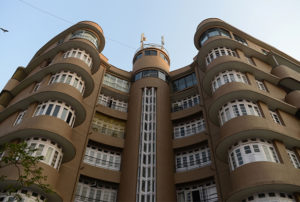
Mumbai, India
With more than 500 stunning examples, Mumbai—especially the waterfront along Marine Drive—is blessed with what some experts think is the second-highest number of Deco buildings in the world. Many of these structures fell into disrepair over the years, but in 2018 they were collectively named a UNESCO World Heritage Site (along with the city’s Victorian Gothic buildings). Mumbai being a port town, many of these relics of the British Empire feature nautical elements that call to mind the era’s luxe ocean liners, including curved surfaces and porthole windows. But what truly sets apart Bombay Deco, as the local iteration has been dubbed, is its infusion of Indian designs and symbolism, including lotus blossoms, elephants, and Hindu deities. One of the most striking examples is the 1936 New India Assurance Building, a reinforced concrete office tower decorated with N.G. Pansare’s stone sculptures, including a woman in a sari hauling grain and a man in a turban carrying mechanical parts. To truly appreciate these hidden-in-plain-sight marvels, book a tour with Art Deco Mumbai.
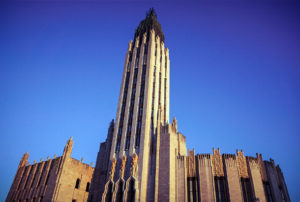
Tulsa, Oklahoma
Thanks in part to its lucrative oil industry, in the 1920s and ’30s Tulsa was able to construct a cutting-edge skyline. From the Tulsa Club Hotel, housed in the 1927 former headquarters of the city’s Chamber of Commerce, visitors can set out to see many exuberantly decorated gems: the 1931 Tulsa Fire Alarm Building, which features a frieze of an Adonis-like man holding the ticker tape–esque emergency alert system; the Public Works Administration–constructed Tulsa Union Depot, which now houses the Oklahoma Jazz Hall of Fame; and the Philcade, oilman Waite Phillips’s eclectic office building, which is home to the Decopolis museum. Perhaps Tulsa’s crowning architectural achievement is the 255-foot-tall Boston Avenue United Methodist Church (pictured), with its modernized, angular take on Gothic forms.
Art Deco Accommodations
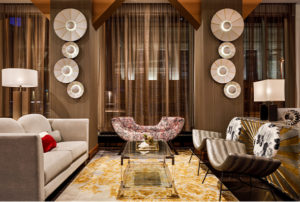
Rand Tower Hotel, Minneapolis
Commissioned by local gas tycoon and World War I aviator Rufus Rand Jr., this 1929 high-rise is an ode to aviation, complete with bas-reliefs of wing-footed Mercuries carrying biplanes and terrazzo floors inlaid with golden compasses and stars. Transformed into a 270-room hotel last December, the Marriott Tribute Portfolio property still contains its showstopping lobby sculpture, Wings, by Oskar J.W. Hansen, the artist behind the sculptures on the Hoover Dam.
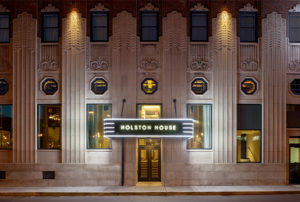
Holston House, Nashville
Opened in 2018 as part of Hyatt’s Unbound Collection, this 191-room hotel occupies a 1929 building designed by Nashville’s preeminent Deco architects, Marr & Holman. Originally the James Robertson Hotel and later converted into low-income housing, the building is one of several the firm created that are now listed on the National Register of Historic Places, including the grand U.S. Post Office building that today houses the Frist Art Museum.
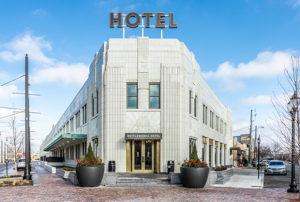
Bottleworks Hotel, Indianapolis
Art Deco beautified even the most utilitarian of structures—including this Indy landmark, once the world’s largest Coca-Cola bottling plant. Last winter, the old factory made its debut as a 139-room boutique hotel. As white and angular as a sugar cube, the building boasts a staircase reminiscent of a fountain and a ceiling fixture meant to evoke soda bubbles. The effect? Guests will surely stop and think, “My, how refreshing!”
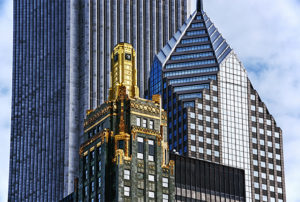
Pendry Chicago
One of the most recognizable towers in The Loop, the Burnham Brothers’ 1929 Carbide & Carbon Building exudes Jazz Age excess. (Chicago lore has it that the green terra-cotta facade and gold-leaf top were intended to mimic a Champagne bottle.) The latest in a succession of hotels that have occupied the building since 2004, the 364-room Pendry opened this spring, complete with Deco-inspired detailing.
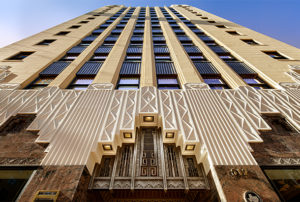
Sinclair Hotel, Fort Worth
Reborn last year as part of Marriott’s Autograph Collection, the 1930 former headquarters of the Sinclair Oil Company is not only an impeccable example of the Zigzag Moderne style, it’s also decorated with Mayan-inspired motifs. Despite its fossil fuel–related history, the renovated building is an eco-friendly marvel, with features such as a backup power system that uses lithium ion batteries.
Los Angeles Landmarks to Toast
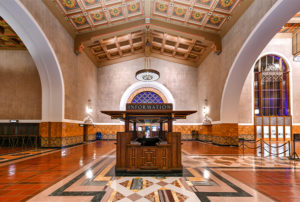
Union Station
In 2018, this 82-year-old Downtown LA icon welcomed the Imperial Western Brewing Company to the space that was once the Fred Harvey Restaurant. What’s more, the station’s hand-painted ceilings were restored just in time for it to host the 2021 Academy Awards.
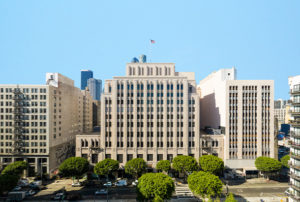
Trust Building
Michelin-starred chef Curtis Stone will soon open an 11,755-square-foot rooftop bar at this 1928 DTLA tower, which is known for its street-level tile murals by Hugo Ballin, who also did the paintings in the Griffith Observatory’s W.M. Keck Foundation Central Rotunda.
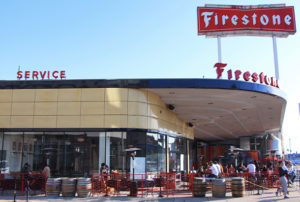
Firestone Tire Building
Built in 1937 in the curvy, aerodynamic Streamline Moderne style, this Mid-Wilshire landmarked building reopened earlier this year as All Season Brewing and Chicas Tacos, after a four-year wait.
Cities with Major Deco Re-Dos
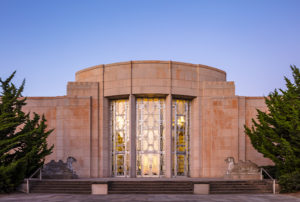
Seamless in Seattle
Last year, the Seattle Asian Art Museum reopened after three years and $56 million of work. Designed by Paris-trained architect Carl F. Gould, the 1933 structure once housed the Seattle Art Museum, and its recent renovations added 13,900 square feet of space. While the glass entrance is still flanked by two marble camel statues, the original Ming Dynasty–era bactrians were moved to safety indoors and replaced with replicas, in response to decades of being a favorite photo-op spot. (Kids fit perfectly between their humps.) Authentic or not, you’ll be surprised at how well their simple forms mesh with the angular geometry of the sandstone facade.
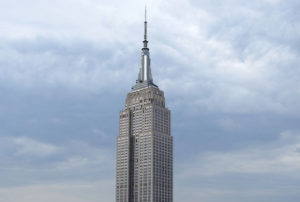
Empire State of Rewind
King Kong, meet Marie Kondo. Preservationists have been busy streamlining and decluttering the Empire State Building’s 200-foot-tall mooring mast, which was built as a theoretical docking point for airships. More than 44,000 pounds of detritus have been removed, including obsolete communications antennae and old support structures, to return the spire to its original design. Pair that work with reimagined observation decks on the 86th and 102nd floors and new museum and exhibition spaces on the second and 80th floors, and the landmark skyscraper is looking as fresh as it did when it opened 90 years ago.
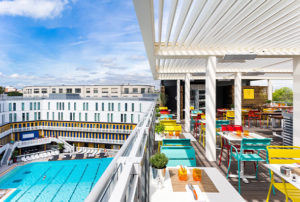
Vive l’Art Déco!
The Art Deco movement can trace its roots—and its name—to the 1925 Exposition Internationale des Arts Décoratifs et Industriels Modernes in Paris, and the City of Light has been a stronghold of the style ever since. These days, many of its icons are getting a much-needed facelift or are being repurposed completely. The grand department store La Samaritaine was set to reopen this spring after a 16-year hiatus, with its splendid Art Nouveau–meets–Art Deco details carefully restored. Nearby, architect Fabrizio Casiraghi recently refurbished the legendary restaurant Drouant, a favorite haunt of Cocteau and Proust; opened in 1880, the bistro was renovated in the late 1920s by Émile-Jacques Ruhlmann—often called “the Pope of Art Deco”—and Casiraghi’s 2019 refresh incorporates Ruhlmann-designed chairs and door handles. Elsewhere, the Musée d’Art Moderne de Paris, housed in the 1937 Palais de Tokyo, received a renovation, while 2017 saw the reopening of the 1930 Piscine des Amiraux, an 18th-arrondissement swimming pool that appeared in Amélie. That pool joins Piscine Molitor (pictured), a landmark public swimming and hotel complex that made a big splash when it was revitalized in 2014.
Next Up: The 21 Best New Hotels of 2021
